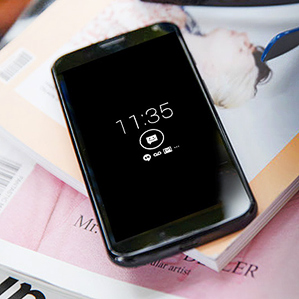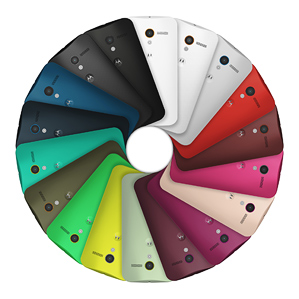
Wake up: The device shows alerts when turned over.
Google-owned Motorola unveiled the Moto X, its new flagship smartphone, in New York City today. The Moto X de?mphasizes manual control, hardware buttons, and the touch screen in favor of always-on sensors built to respond to speech, gestures, and context. And customers will be able to customize many features of the device when they order it.
The phone?s ?touchless control? interface is its biggest innovation. Without switching on the device, simply saying ?Okay Google Now? followed by a command can make a phone place a call, get directions, perform a Google search, or more. The phone?s accelerometer can also tell whether you?re in a moving car and tailor its commands and notifications accordingly.
Since it could be a huge drain on battery life to have sensitive sensors running around the clock, Motorola added two additional tiny processors to the Snapdragon S4 Pro system-on-a-chip. One is for natural language processing, and the other is for ?contextual computing? (in other words, managing all the phone?s other sensors). Both processors are built for extremely low-power use. Motorola designed the processors themselves; they are not built on the ARM architecture, and the company will not disclose who?s fabricating them. But it?s these chips that make all of the new button-free interfaces possible, while still allowing up to 24 hours of mixed usage and 13 hours of talk time.
The new chips also make other ?contextual computing? possible without requiring the user to touch a button or screen. Turn the phone face up, and it displays the time and notifications. No buttons pressed, no power-draining backlight turned on: the LED display only lights up the pixels needed to show the time. Motorola calls this an ?active display.? If you hold the phone up and twist your wrist, this activates the phone?s camera, reducing the time between pocket and portrait to two seconds. The Moto X comes with a 10-megapixel camera and 50 gigabytes of Google Drive storage, free for two years.
Observers have been waiting for the phone for two years, since Google announced it was buying Motorola Mobility. Motorola CEO Dennis Woodside calls the Moto X ?the first phone designed from scratch? post-acquisition. On quarterly earnings calls, Google CEO Larry Page has promised revolutionary new devices that would solve the problems of durability and battery life that still plague smartphones (see ?What New Ideas Does Google Have Brewing at Motorola??) once Motorola?s existing product pipeline cleared (see ?Motorola Shows Off First Smartphones Under Google?). Since then, Motorola?s ?X Phone? has been rumored, teased, leaked, and marketed for months.

Color scheme: The Moto X will be offered in a variety of colors and materials.
As expected, the Moto X has a 4.7-inch Gorilla Glass screen that runs nearly edge-to-edge across the phone?s face, and a plump, rounded back that accommodates its custom-shaped battery and fits in the hand more like a mouse than the flat slate popular in today?s smartphones.
Motorola is touting the phone?s customizable colors and features, and the fact that it will be available on every major carrier in the U.S. and many more worldwide by late August or early September. The phone is also being assembled in Fort Worth, Texas, which makes it possible for U.S. customers to get a customized device in four days.
At Thursday?s event, Motorola?s senior vice president Rick Osterloh presented this phone as the culmination of Motorola?s 40 years of work on mobile communications. Citing smartphone makers? ?lack of innovation? and ?lack of imagination,? Osterloh said that the team assigned to develop the Moto X discovered that ?smart phones weren?t very smart??a direct echo of what Steve Jobs said before presenting the first iPhone.
In fact, relatively few features of the Moto X haven?t already been incorporated in Motorola?s Droid line of smartphones for Verizon, which deflates their impact. And because of the X?s long gestation, many of the wilder rumors about the phone turned out to be hot air. But it is still a milestone device and, if it?s successful, it could change the smartphone industry?s status quo.
Customization could be a big selling point of the Moto X in the United States. ?Cars let you customize the interior or exterior,? said Osterloh, ?but with phones, which are probably our most personal technology or object, you get to choose between black, white, and maybe silver.? The Moto X comes in 18 back and seven accent colors, as well as a white or black front.
Initially, however, this level of customization is only for customers in the U.S. on AT&T?s network. Most of the world gets to choose between textured white or textured black. Motorola says other carriers will be added to the Moto Maker customization program later in the year.
It?ll be possible to tailor a device at the AT&T store or online at motomaker.com. Most of the backs are either a smooth or textured polycarbonate, but Motorola is also experimenting with wooden backs. Although this won?t be available at launch, Motorola showed off finishes in bamboo, teak, ebony, and rosewood at the New York event.
Because the devices are assembled in the U.S., Motorola can configure and ship them in any customization within four days. If you?re unhappy with your custom phone, within 14 days you can ask for a return, and Motorola will ship you a new device with a prepaid FedEx box to return the old one.
?Every selection on the Moto Maker website checks the part?s availability in real-time,? said John Renaldi, the director of Moto Maker. ?Every one of our manufacturing lines can immediately switch to become a customized line,? depending on the distribution of orders.
Motorola?s goal, said Renaldi, was to export this on-the-fly customization ability to its factories all over the world. For now, Fort Worth?s proximity to Motorola?s design centers in Chicago and California make it Moto?s perfect pilot factory.
Forrester analyst Charles Golvin said that Motorola?s emphasis on customization speaks to the saturation of the current smartphone market, and was surprised that Motorola priced the Moto X at $199 on a two-year contract, given its goal of making ?a phone for everybody? and the difficulty of competing with the iPhone and other top smartphones at that price.
The most lasting impact of the Moto X will be beneath the surface. Local, just-in-time assembly may shift how and where many electronics are manufactured and make customization more common. Phone makers are also looking to larger possibilities for speech, proximity, and motion sensing, and beefing up their processor designs accordingly. Whether the Moto X is Motorola?s iPhone moment or not, it shows where mobile computing is headed.
Source: http://www.technologyreview.com/news/517676/motorola-reveals-first-google-era-phone-the-moto-x/
Teen Wolf linkedin linkedin Frank Lautenberg Pia Zadora chicago blackhawks Alexandra Lenas
No comments:
Post a Comment
Note: Only a member of this blog may post a comment.